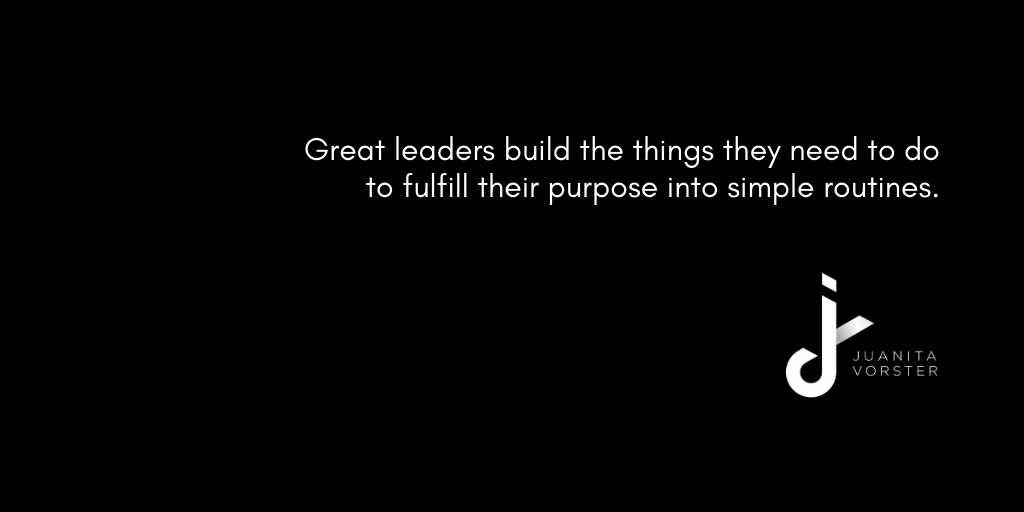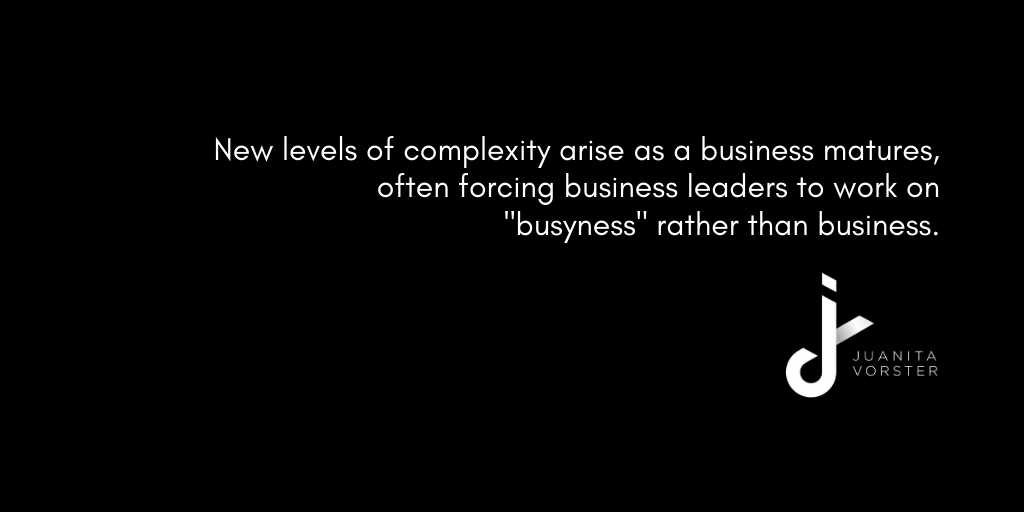|
The recipe for business success is simple ... even if it isn't easy.
In business, effort and sacrifices only hold value if they produce results that others are willing to pay for.
Are you building busyness, or are you building a business? And what about the people you pay to help you build the business? Is everyone doing what they're supposed to be doing and in the way they're supposed to be doing it? When last have you reviewed the proposal and pitch structure and content you (or your sales team) use?
It's easy to habitually use an existing template that ticks all the information boxes, but what about the influence factor? Yes, a prospective client wants to gauge credibility, but more than that they want to know how well you understand their problem and how you're going to solve it better than anyone else.
The poor Comfort Zone. It's been getting a bad rap for years!
Popular activities for team-building include exercises to help teams think outside the box, workshops that force us outside our comfort zones, seminars are designed to inspire attendees to embrace discomfort in the name of personal growth ... the list goes on. As with every story, there is more than one side to the tale of the Comfort Zone. In the zone When inside a comfort zone, the flight or fight response is significantly reduced, and therefore people can think and act with clear minds and passion in their hearts, because situations aren't clouded with anxiety or fear. Inside a comfort zone, a person can use all of their energy to be the best version of who they truly are, instead of a mediocre version of what theories and popular culture seems to demand. The result of this best version of a confident, relaxed and authentic person is an environment where high performance comes very naturally. Zone out For purposes of growth and balance, it is necessary for everyone to move to a place of discomfort every now and then, with the focus on "every now and then". When exposure to experiences outside ones comfort zone occurs in an environment where time and risk can be managed, and expectations are proactively communicated, the experiences can lead to high learning, which is why pushing the boundaries of ones comfort zone is so popular. The crux Very simply, my point is this: Bringing learnings from outside of the comfort zone together with high performance inside of the comfort zone makes for authentic personal and professional growth. No workshops, no seminars, no exercises necessary. The practicalities Imagine if all workplaces had the privilege of ensuring during the recruitment stage to select team members with a perfectly balanced team of strength profiles that accommodate the weaknesses of others. A team that moves comfortably in and between a variety of comfortable skill sets, sensitivity levels, and life experiences. Imagine if leaders had the skills to guide their teams on the weaving journey between high performance and new experiences. Imagine if we all had the confidence to feel comfortable with feeling comfortable, and not fear the discomfort that goes hand in hand with growth. With the MASSIVE changes that struck business in recent years, it is incredibly important that business leaders learn to be comfortable - and teach their people to be comfortable - with moving in and out of comfort zones. It is one of the most important skills needed to WIN! in the new game of business. Back in 2013 for my company year end function we went glass blowing. What an experience! I expected to be forced outside of my comfort zone (and have fun at the same time) but I did not expect a valuable leadership cliché to be proven during our session. At one point during our glass blowing workshop the facilitator wanted us to attempt a technique without showing us the ropes first. My initial reaction was to let one of the others go first, as my personal habit is to observe first and learn from the mistakes others make. However, the team was quick to voice their preference that I go first. I realised then that ‘leading from the front’ does not allow for a personal culture of perfection and saving face. It implies getting dirty and even potentially losing face. As explained on a military forum: “In times of great chaos someone must remain sane to steady the group and drive [the group] through the point of friction. This is the job of all leaders of all ranks.” Leaders must embrace risks and accept discomfort in order to create and maintain an environment for their team in which the team members can safely explore, ask questions, experiment and learn. The face to be saved is that of the team, not that of the leader. Nelson Mandela perfectly described the only time a leader can afford to lead from the back. “It is better to lead from behind and to put others in front, especially when you celebrate victory when nice things occur. You take the front line when there is danger. Then people will appreciate your leadership.” A few photos from the day ... and yes, that's me with darker, longer hair ;-) Business success isn’t only reserved for large corporations with seemingly unlimited budgets. There are countless stories of small businesses that have grown to incredible heights simply by treating customers in a way that made them want to share their experience with family, friends, colleagues and on social media and encourage them to try it for themselves. Customer experience can no longer be treated as an afterthought delegated to a single department. It has to be central to the entire organisation as it is a key ingredient to being exceptional: one of the four fundamentals of winning in the new game of business. Exceptional organisations offer products or services that exceed all industry averages and customer expectations. Having a great product or service is however only one dimension of delighting customers. With all the options they have available these days, customers simply don’t want to work hard to figure out how to give you their money. They don’t only want exceptional products and services; they want to deal with organisations in a way that is easy, efficient and memorable for all the right reasons. This is the second dimension of customer experience. The third dimension is the "what else" bit. The over-and-above part of the entire experience that changes it from acceptable to memorable. This is where organisations can be really creative. Great customer experience isn’t just something that happens – it has to be designed. Exceptional organisations pay at least as much attention to designing the customer experience as they do designing products and services – often even more. A well-designed customer experience is an incredibly valuable business growth tool that keeps customers coming back and bringing others with them. The four questions any business of any size in any industry must ask when it designs its unique customer experience are:
It was rainy. It was a Monday morning. One of the kids' last clean pair of school pants had a hole that needed mending NOW, eating into the precious minutes of a highly orchestrated morning routine. But it was still OK. And then I found that all my gym clothes seem to have made their way to the "next load of laundry" pile. Enough legit excuses to skip gym 🎉🎉🎉 Except for a mantra from purpose proponent Richard Wright that popped into my head to ask: "How much do you want it?" And that's how I ended up at the gym in an old scruffy pair of jodphurs left over from my horse riding days. Winning in business requires constant innovation, and innovation rarely starts with having or buying "the right" equipment/tools/tech. Innovation is all about using what you already know and have and applying it in a way that it might not have been intended or designed for. "I can't get a loan." "I'm not tech savvy." "My employees/colleagues don't want to change." "Our customers like it the way it is." "How much do you want it?" -- #newgameofbusiness Our internal reward system drives us to do what we like to do. What we need to do to fulfill our chosen purpose is however not always what we like to do. That’s why it’s so important to plug our “purpose fulfilling activities” into routines; behaviors driven by habit, not by choice. My morning routine sets me up to WIN according to my chosen purpose: making success simpler for my fellow business leaders. To fulfill this purpose, I need to have enough mental, emotional and physical energy available. The problem with this is that I don’t like any of the healthy habits that secures the necessary energy! If I choose to do only what I like every day, I will never end up where it is I’ve set out to go. And if I choose what to do only what I need every day, I’ll eventually run out of willpower. So instead of having to choose between what I like and what I need every day, I’ve built the things I need to do to fulfill my chosen purpose into a simple morning routine: wake up when alarm tells me to, drop the kids off at school, do about 40 minutes of weightlifting at the gym, and chug down a protein shake as soon as I get home. Whatever I then do during the rest of the day takes care of what I need to do in the short term to fulfill my chosen purpose, like running my company, taking care of clients and colleagues, and securing new opportunities. Routines connected to purpose are powerful tools for helping us do things that will reward us over the long term. But routines not connected to purpose are powerful tools for keeping us doing things that give us a false sense of control and security. Which routines are helping you to WIN in business and which routines are just keeping you busy?
Hi Juanita, I want you to show me how to
Do you remember what life was like right before you received the message that confirmed your appointment as executive? Or before you started your own business? Or before you took over the family business? Opportunities lay ahead like an orchard of fruit trees ripe for the picking and everything that frustrated you about your career up to that point seemed like it was finally going to change for the better. Right? If your journey was similar to that of most business leaders, that feeling only lasted for about a year or two. Leading a business does not become easier the longer you do it, even though you become better at doing it. New levels of complexity arise as a business matures, often forcing business leaders to work on "busyness" - or in the business - rather than working on the business.It's easy to spend unlimited time reacting to things others highlight as urgent or important. It's much harder to figure out how to get - and stay - on top of the things that will truly influence the sustained profitable growth of a business: purpose, products, processes and progress. Turn PURPOSE into profitTo be able to effectively choose where to spend time, effort and resources it is of utmost importance that business leaders understand what the core purpose of their organisation is. Running a business to sell it requires a completely different approach than growing it for long-term success. If the purpose is to grow the business then the owner or appointed executive (CEO or MD) need to be crystal clear on:
Knowing the answers to these three questions will help any business leader to make decisions based simply on the test of "will this move us towards or away from our core purpose?". Have PRODUCTS for "now" while planning for "new"The products and services offered by a business should not just align to its core purpose; it should also be hyper-relevant in a fast-changing world. Business leaders have to keep an eye on developments across various markets to stay ahead of the curve. Being too busy maintaining the current offering and making no time for exploring (or assigning and monitoring) product or service innovation is a massive risk for any business. As leader you've got to become highly skilled at making sure the business earns "now" money while simultaneously preparing to generate "new" money. And of course, the process of buying these products and services should be as frictionless as possible for clients. Let your PROCESSES serve them, not just youA fantastic product that can only be bought through a cumbersome process will always be under threat. The buying process must be designed to delight the customer. Too many processes seem to serve only the convenience of the business. In a world filled to the brim with options, customers will often buy something that might be a little bit inferior but a lot more convenient for them to buy. Just because a buying process exists doesn't mean it should be left to carry on. Continuous process improvement must remain high on the proactive priority list of any business leader. Chase only the PROGRESS that mattersProgress in either products/services or processes should not be allowed to just sprout and grow in any direction. It should be strategically driven by the business leader in a direction and pace that supports the financial, social and brand purpose of the business. Progress for the sake of it often ends up just increasing the busyness of the business leader, rather than the business they need to be working on. The approach to successfully on top of these elements for sustainable profitable growth is contained in the "Staying in the Helicopter®" programme.
It is presented across the world exclusively by Juanita Vorster and Roger Harrop and has to date enabled more than 30,000 business leaders to carve paths of success in a business world that has undergone enormous change in the last decade, with lots more change predicted to come. |





 RSS Feed
RSS Feed
